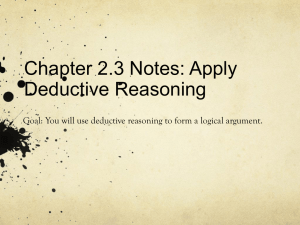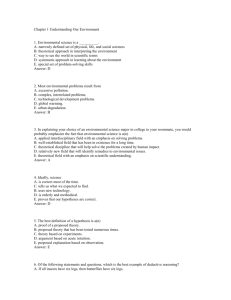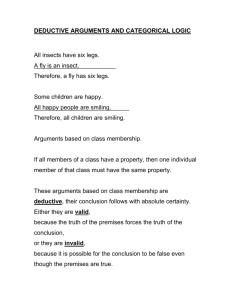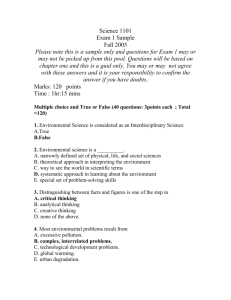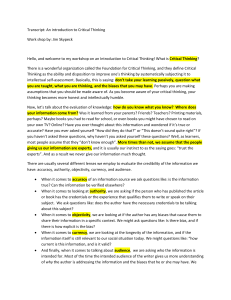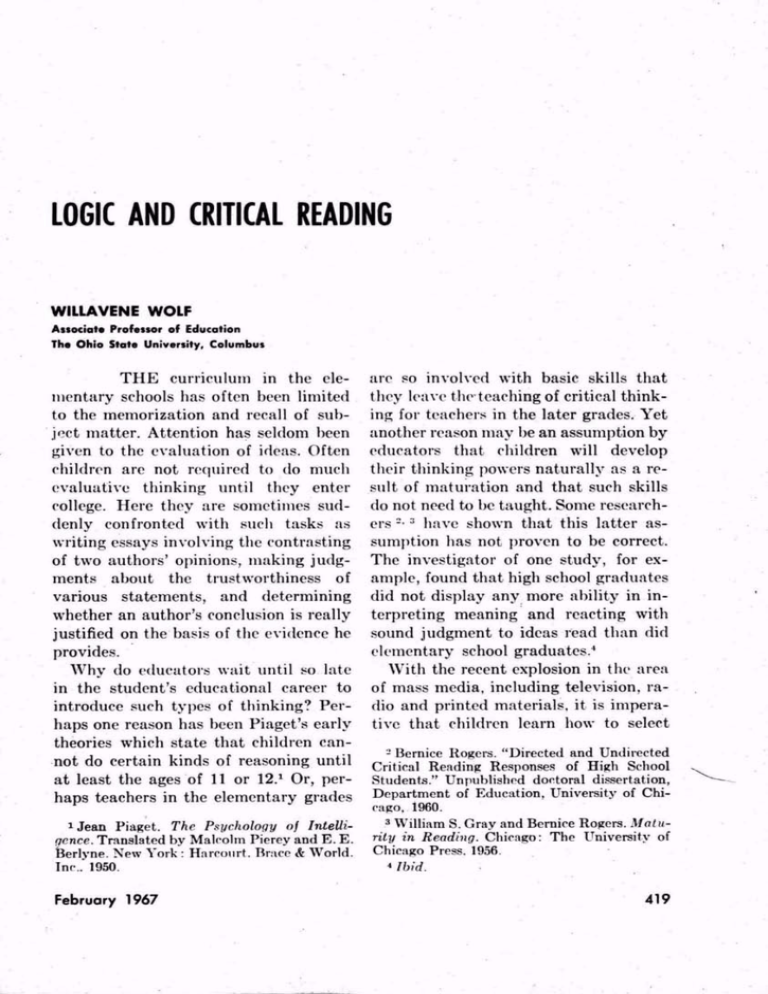
LOGIC AND CRITICAL READING
WILLAVENE WOLF
Associate Professor of Education
The Ohio Slat* University, Columbus
THE curriculum in the ele
mentary schools has often been limited
to the memorization and recall of sub
ject matter. Attention has seldom been
given to the evaluation of ideas. Often
children are not required to do much
evaluative thinking until they enter
college. Here they are sometimes sud
denly confronted with such tasks as
writing essays involving the contrasting
of two authors' opinions, making judg
ments about the trustworthiness of
various statements, and determining
whether an author's conclusion is really
justified on the basis of the evidence he
provides.
Why do educators wait until so late
in the student's educational career to
introduce such types of thinking? Per
haps one reason has been Piaget's early
theories which state that children can
not do certain kinds of reasoning until
at least the ages of 11 or 12. 1 Or, per
haps teachers in the elementary grades
1 Jean Piaget. The Psychology oj Intelli
gence. Translated by Malcolm Pierey and E. E.
Berlyne. New York : Harcourt. Brace & World.
Inc.. 1950.
February 1967
arc so involved with basic skills that
they leave the teaching of critical think
ing for teachers in the later grades. Yet
another reason may be an assumption by
educators that children will develop
their thinking powers naturally as a re
sult of maturation and that such skills
do not need to be taught. Sonic research
ers - • 3 have shown that this latter as
sumption has not proven to be correct.
The investigator of one study, for ex
ample, found that high school graduates
did not display any more ability in in
terpreting meaning and reacting with
sound judgment to ideas read than did
elementary school graduates. 4
With the recent explosion in the area
of mass media, including television, ra
dio and printed materials, it is impera
tive that children learn how to select
- Bernice Rogers. "Directed and Undirected
Critical Reading Responses of High School
Students." Unpublished doctoral dissertation,
Department of Education, University of Chi
cago, 1960.
3 William S. Gray and Bernice Rogers. Matu
rity in Reading. Chicago: The University of
Chicago Press. 1956
« Ibid.
•
'
419
and evaluate ideas rather than to ab
sorb them without question. This is par
ticularly important with relation to
printed materials, since print seems to
lend credence to ideas.
One way children can learn to evalu
ate informational and argumentative
materials is through instruction in logic.
Logic can be defined as the study of rea
soning. It involves systematic and criti
cal thinking. Here critical means mak
ing favorable as well as unfavorable
judgments based upon a knowledge of
principles and standards appropriate to
a given subject matter.
Just as a book reviewer gives both the
positive and negative points of a book
and substantiates his judgment with
reasons, so must the critical reader.
Thus, a reader, who is trying to im
prove his thinking about the printed
page, must have in mind some criteria
for discriminating sound reasoning
from unsound reasoning.
Concepts of Logic for
Elementary School Children
There are two kinds of logical reason
ing that have been distinguished: deduc
tive and inductive.
Deductive Reasoning. Deductive logic
involves the drawing out of those im
plicit beliefs which must be accepted if
certain other beliefs are accepted. It
shows what necessarily follows from the
endorsement of a given set of ideas.
When it is impossible for the premises
to be true without the Conclusion being
true, an argument is called valid, i.e., i t
is internally consistent. No information
other than that contained in the reasons
is used in a conclusive argument. An ar
gument that is conclusive is said to be a
February 1967
deduction and, in a sound deduction, the
conclusion is said to follow from the
premises.
Checking the reasoning of printed
materials is often difficult because the
arguments presented there usually take
much for granted. Many premises are
merely assumed and need to be made ex
plicit before the reader can evaluate
them. Also, the logical process is usually
implied and seldom stated as such in
printed material. Hence, it is often nec
essary to change the wording of the
original statements in order to construct
the major and minor premises. In doing
this, the reader must be careful not to
change the thought of the author.
Although logic has commonly been
regarded as a subject restricted to col
lege classes, the staff of the Critical
Reading Project 5 at The Ohio State
University took the position that many
aspects of logic as applied to reading can
be taught in the elementary school.
They presented the following elements
of deductive reasoning to elementary
school subjects:
1. How a deductive argument is de
veloped, including practice with syllo
gisms
2. Converting statements in print into
logical form
3. Recognizing various authors' use of
all, some and none statements
4. Identifying hidden assumptions
5. Recognizing groups and subgroups
in classification
5 This research is being performed pursuant
to a contract with the Office of Education.
U.S. Department of Health, Education, and
Welfare, under the provisions of the Coopera
tive Research Program. Principal investiga
tors, other than the author, are Charlotte
Huck and Martha King.
6. Determining whether various de
ductions are valid.
In the initial lessons, examples were
taken from the children's own experi
ences. Concepts were introduced gradu
ally. For example, children practiced
drawing conclusions from two given
premises before they were required to
find hidden assumptions. Most of the
materials had to be developed specifi
cally for the project since materials em
ploying deductive reasoning were vir
tually unavailable for the lower grade
levels.
Inductive Reasoning. I f either of the
premises of an argument is false or even
questionable, no amount of deductive
logic can guarantee the truth of the con
clusion. Hence sound reasoning depends
upon both valid relationships and reli
able premises. Inductive logic concerns
the means of attaining reliable beliefs or
checking the reliability of statements.
In evaluating printed material there
are various ways to discriminate be
tween reliable and unreliable testimony.
For example, the reader should learn to
examine the way the author has used
words and to identify techniques often
used by authors to influence thought and
action. Sometimes the reader can detect
unsound statements simply by outlining
the argument. Other ways to detect un
reliable testimony are to determine if
the author has competence in the field in
which he is writing, to note the source
of the article and to check whether the
statements would be corroborated in
other sources.
The Critical Reading research team
at The Ohio State University attempted
to discover the capability of children in
the following aspects of reliability:
February 1967
1. Recognizing the difference between
fact and opinion
2. Detecting fallacies such as hasty,
unrepresentative and faulty causal gen
eralizations; post hoc reasoning; faulty
analogies; false dilemmas; all-or-noth
ing mistakes; and composition and divi
sion
3. Recognizing propaganda devices
that employ various fallacies such as
bandwagon, testimonial, transfer and
card-stacking
4. Determining when words are too
vague
5. Establishing the reliability of var
ious sources and authorities.
Generally, teachers reported that re
liability was easier to teach than valid
ity of arguments, particularly when
examples were drawn from the children's
own experiences, and that detection of
isome fallacies in materials was possible
at all grade levels. .'".-•
Testing Children's Ability
To Use Logic
Can children in the first through sixth
grades be taught how to use logic in
evaluating materials? In order to an
swer this question, a section on logic
was included in the Critical Reading
Tests developed at The Ohio State Uni
versity, normed on a national sample
and used as the Criterion Measure in the
research project. Separate tests were de
veloped for the primary and intermedi
ate grades. The test questions on logic
required the children to draw conclu
sions from given premises; to find hid
den assumptions; to understand the
meaning of a((, some and none state
ments; to detect various kinds of falla
cies and, in general, to be able to apply
423
certain rules of logic to printed material.
After a pretest, children who were sub
jects for the research were given lessons
in logic and other critical reading skills
for several months and then post-tested.
In grades three through six, children
were given lengthy instruction and prac
tice in both deductive and inductive
logic. Although a few lessons on deduc
tion were included also in the first and
second grades, the teaching of logic was
confined mainly to evaluating the trust
worthiness of statements. It was found
that children at all the grade levels made
significant gains over the control groups
in their logic scores. Seemingly, the
easiest and most transferable concept at
all grade levels was that of identifying a
generalization. By the end of the year,
even first grade children were saying to
their teachers, "No, Mrs. Jones, we are
not all talking. Jimmy isn't talking. Sue
isn't talking. I'm not talking. . . ."
Children observed in one second grade
classroom were almost 100 percent cor
rect in their identification of generalized
statements given by the teacher. For ex
ample, when the teacher wrote on the
board, "All old people wear glasses," one
youngster replied, "That's an untrue
generalization. My grandmother doesn't
wear glasses and she's old." Children
had most difficulty identifying untrue
generalizations when the generalization
agreed with their beliefs. For example,
"All policemen are brave," was not ques
February 1967
tioned, even with persistence by the
teacher.
In the realm of deduction, children
had the most difficulty working with
valid syllogisms that .had untrue major
premises. If the first major premise read,
"All girls are smart," most of the boys
preferred to discuss the reliability of the
statement rather than accepting it as
true in order to check the validity of the
entire argument.
In interviews, teachers emphasized
several points of good instruction ap
plicable to the teaching of logic in read
ing, such as: (a) using good examples as
well as bad in teaching reliability; (b)
requiring children to apply the concepts
to the printed material soon after they
were taught; (c) involving the children
actively in writing activities along with
reading; (d) introducing concepts grad
ually throughout the year and keeping
the lessons brief; and (e) requiring chil
dren to tell why they believe an author's
reasoning is sound or unsound rather
than responding simply "yes" or "no."
Further analysis of the research data
is presently under way and may provide
answers to such questions as which logic
skills can be taught at the various grade
le/vels and what the relationship is be
tween selected subject characteristics
and their logic scores. Numerous other
questions, including what techniques
are best for teaching logic, still remain
<*§
unanswered.
425
Copyright © 1967 by the Association for Supervision and Curriculum
Development. All rights reserved.



